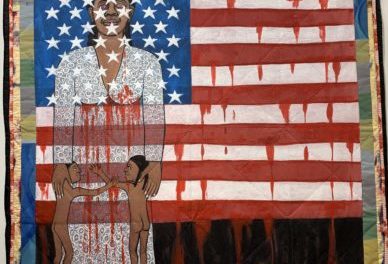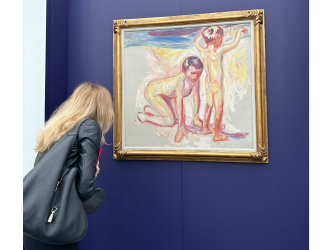Saint Laurent, Loulou de la Falaise, Betty Catroux

In François Catroux Rizzoli publisher
Great creatives, who are so unique, tend to feel the need to create a close-knit circle around them. This is true of Yves Saint Laurent, whose two best friends became legendary muses: Loulou de la Falaise and Betty Catroux.
Six exhibitions
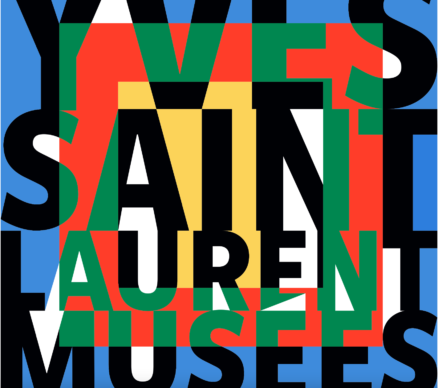
The couturier, who is due to be the subject of no less than six exhibitions starting from 29 January 2022 in six Parisian museums, including the Orsay and the Pompidou, had a life – like his two fascinating accomplices – that was defined by fantasy, poetry, and beauty, but which also had its troubles and other addictions.
Pierre Bergé
The operational aspect of his life was organized by his partner, Pierre Bergé (See here the video interview I did with Pierre Bergé speaking about Robert Mapplethorpe).
Betty and François

François Catroux, Rizzoli ed
The situation seems to have been similar for the Catroux couple. Betty, who had a good sense of humour and liked to say, “I’m a complete good-for-nothing. My only glory is that I attracted a genius like Yves,” had a pillar of her own called François Catroux (1936-2020) whom she married in 1967 and stayed with for the rest of her life.
Betty Catroux
Since her husband’s death Betty Catroux seems to have withdrawn somewhat. The woman who was the subject of an exhibition at the Musée Bergé Saint Laurent in Paris in 2020 conducted a very interesting interview with Sofia Tchkonia for Showstudio in 2015 in which she spoke about Saint Laurent, her husband and her marriage.
The grandson of the famous General
This interior designer, born in Algeria, was the grandson of General Catroux, a liberation fighter and minister under the Fourth Republic.
Rigour and zeitgeist

François Catroux’s designs
From this lineage, Catroux the interior designer inherited a certain discretion and rigour which were clearly reflected in his work, combined with a keen interest in the zeitgeist, not only within the YSL circle but also in relation to art and contemporary design.
Sotheby’s
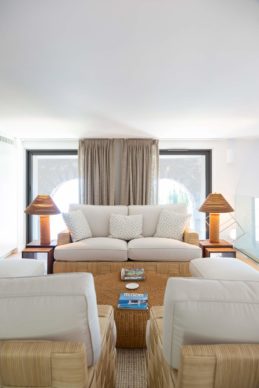
Palais Maeterlinck
On 24 February 2022 Sotheby’s is staging the sale in Paris of the contents of the last apartment acquired in 2018 by Betty and François, in Nice.
Palais Maeterlinck
Located in the Palais Maeterlinck, which takes its name from the poet who had it built, their niçois apartment overlooked the Baie des Anges.
1 million euros
The operation, estimated at 1 million euros, may not be spectacular, but it is a good encapsulation of a kind of Parisian taste from the 1970s and 80s which was pioneering at the time.
Embodiment of modernity
“When I was starting out François was, in my view, the embodiment of modernity, a blend of rigour and glamour who knew how to mix eras. I admired him,” recalls Jacques Grange, the official designer of Yves Saint Laurent’s apartments. I interviewed Jacques Grange about Yves Saint Laurent in 2017.
Abramovich
François Catroux address book had clients such as the Russian oligarch Roman Abramovich, huge Greek fortunes, and the fashion designer Diane von Furstenberg.
With Saint Laurent at 12
The latter reveals in the introduction to a book on the designer’s interiors, published in 2016 with Rizzoli, that it was while François was at boarding school in Algiers at the age of 12 that he met Saint Laurent, before later seeing him again in Paris.
Diana von Furstenberg

François Catroux’s designs
Diane von Furstenberg made his acquaintance at a dinner at his apartment on the Île Saint Louis, after it had been photographed by the famous Horst P. Horst for American Vogue. “Yellow and white, bare and gleaming, it looked like an abstract painting from the time. Maybe a Vasarely or an Albers.” Here she was alluding to two artworks that we can find at the Sotheby’s sale.
Maxime Catroux
“The apartment was extraordinary, animated by its rigorous style, made up of symmetries. It wasn’t a bohemian house. My mother wasn’t involved in the decoration at all,” says one of their two daughters, Maxime Catroux, about the space at the Palais Maeterlinck. “He spent some time there before his illness. It was his life’s dream, overlooking the sea, a reference to a magical time in his youth.”
Tom Wesselmann
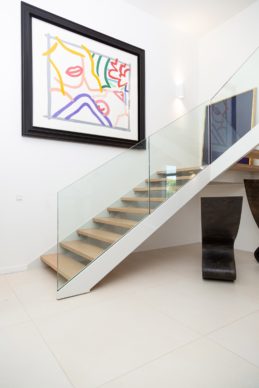
In Palais Maeterlinck
Featuring prominently was a painting on paper from 1984 by the American Pop artist Tom Wesselmann entitled “Bedroom Blonde With Purple Pillow”, which could easily have been a stylised portrait of Betty Catroux (estimate: 100,000 euros).
Ron Arad
One of the big names at the sale is the Israeli designer who lives in London, Ron Arad (born in 1981), who was the subject of a large-scale retrospective at the Centre Pompidou in 2008 followed by Moma in New York. He created sinuous forms in worked metal, but also a lot of financial speculation surrounded his work from this period…
Drop in demand

François Catroux’s designs
Since then, things have been going less well for Ron Arad, who has seen a notable drop in demand. I interviewed him back then for the catalogue of his exhibition at the Pompidou in his London studio.
Easy money
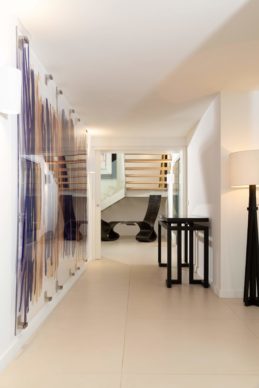
Palais Maeterlinck
He said: “I don’t like it when pieces go to auction. It creates a false sense of urgency. These days auctions are just used as a clever way to make easy money” (1). He was right to distrust the auctioneer’s hammer. According to the Artprice database, the prices for Ron Arad fell by 17.5% in 2021 and 100 euros invested in one of his pieces in 2000 would be worth on average 51 euros today.
Record price in 2021
But since nothing is straightforward when it comes to the art market, the record price for this designer was obtained in 2021 for a sofa in metal, three copies of which exist, the “D Sofa”, which sold for 1.1 million euros.
François Laffanour
“The pieces made by Arad as part of his first initiative, ‘One Off’, continue to register a very strong demand,” observes his dealer in Paris, François Laffanour from the Downtown gallery. And indeed the four lots presented at Sotheby’s, comprising seats and tables, come from this period, between 1988 and 1992, when he was establishing his visual vocabulary.
Ettore Sottsass
Another of the remarkable pieces at the sale is a colourful console by the designer Ettore Sottsass (1917-2017). The Centre Pompidou staged an exhibition on him with the title “Ettore Sottsass, l’objet magique” (Ettore Sottsass: the magical object) on view until 3 January 2022. It addressed its subject by giving a sense of ritual to everyday pieces.
The magic
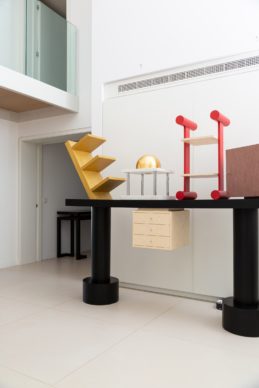
Ettore Sottsass
“I’ve always thought design began where rational processes end and where magical processes begin,” explained the designer who was behind unique works such as towers and totems. “Many things go back to the meaning of tools and objects as catalysts for ritual. A Chinese teacup naturally comes to mind (…) These are tools and things that make us feel present and alive” (2). In 1981 he formed the Memphis group which developed unprecedented forms in design, playing with a great density of colours and patterns.
Acropoli console
The “Acropoli” console from the Catroux collection, in painted wood, steel and marble and made in 1988, perfectly embodies this principle (estimate: 12,000 euros). “Sottsass is a designer who produced a lot. His creations are defined by a strong presence, but he is enjoying a renewal of interest from a circle of specialists,” observes Florent Jeanniard, head of the design department at Sotheby’s.
Full-blown artist
For François Laffanour, “the Sottsass market is consolidating. It looks set to see a significant rise. His work is made up of various strata and is relatively complex, with pieces from earlier and a large number of recent works. But it soon becomes clear that he is much more than a designer. He’s a full-blown artist.” Given his importance, his value still remains relatively reasonable. The record price at auction for a piece by the great Sottsass is 355,000 euros for a composition made out of a mirror and a bookshelf, dating from 1959.
Martin Szekely
The sale also contains a pedestal table, an early piece by the French designer Martin Szekely (born in 1956). This little Pi table in lacquered steel has an estimate of 2000 euros.
“It has to be attractive,” says Florent Jeanniard, justifying the generally low estimates of the sale.
His ability

François Catroux’s designs
From the ensemble presented at Sotheby’s on 24 February we recall that François Catroux had the ability to choose pieces that were made early on by designers and that they all share the commonality of being made up of pared-back lines.
Big interest in interiors
Against the backdrop of the public health crisis, and while the entire planet has been limited in terms of its movement, over the past three years interest in interiors and furnishings, especially dating from the second part of the 20th century, has rarely been so sustained.
Karl Lagerlfeld
Thus in the sale dedicated to the Karl Lagerfeld collection on 14 December 2021 at Sotheby’s in Paris (with an estimate of 2 million it actually brought in 14 million), a Soleil Noir mirror by Martin Szekely, made in 2007, sold for 375,500 euros (its estimate was 10,000 euros). Not to mention the prices that are rising exponentially for decorative pieces by François-Xavier and Claude Lalanne (read the reports on the couple here and here), we also note a major rise in prices for creators from the 1950s such as Charlotte Perriand and Jean Prouvé, among others.
Major rise in prices
On 3 November 2021 Christie’s dispersed the design collection belonging to Belgium-based businessman Daniel Lebard. It brought in 31.6 million euros while having an estimate of 13 million. Exceptional furniture is gaining ground in terms of its value, coming up to rival art prices. There’s no reason for this trend to reverse, at least not in the short term.

François Catroux’s designs
All the photos untitled “François Catroux’s designs” come from the book published by Rizzoli in 2016: François Catroux. Author David Netto.
(1) Ron Arad; No discipline. Catalogue du Centre Georges Pompidou 2018.
(2) Ettore Sottsass. L’objet magique. Centre Pompidou. 2021
Support independent news on art.
Your contribution : Make a monthly commitment to support JB Reports or a one off contribution as and when you feel like it. Choose the option that suits you best.
Need to cancel a recurring donation? Please go here.
The donation is considered to be a subscription for a fee set by the donor and for a duration also set by the donor.


